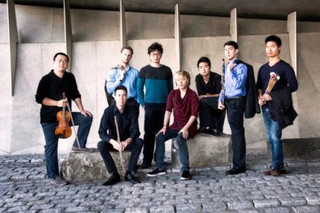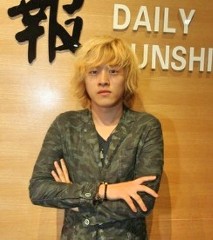|
Back
The Imperial Banquet:From Flute to Notes New York
Kaufmann Hall
11/04/2014 -
Toro Takemitsu: Air
Isan Yun: Interludium A
Ying Wang: Cycle (U.S. Premiere)
Kenji Sakai: Concerto dfAutomne (New York premiere)
Lei Liang; Gobi Canticle
Shiuan Chang: åX¬J (Street) (U.S. Premiere)
Kaito Nakahori: Japanese Footbridge (New York Premiere)
Hai-Dao Ensemble: Thomas James Wible (Flute), John Diodati (Clarinet), Yuan Quan (Violin), Sebastian Baverstam (Cello), Zenan Yu (Piano), Wei-Chen Lin (Percussion), Yoko Reikano Kimura (Koto), Kaito Nakahori, Shiuan Chang (Artistic Directors/Conductors)

Hai-Dao Ensemble (© www.kaitonakahori.com)
A poor audience turned up for a very rich program last night, the very first New York performance of Hai-Dao Ensemble.
And who is (or are) Hai-Dao? The Mandarin word for gislandh, Hai-Dao was founded at the New England Conservatory by Japanese-born Kaito Nakahori and Taiwan-born Shiuan Chang, both from island territories. Plus, islands (as they explain in a beautifully elaborate program) gresemble an important characteristic of every artist: independence.h
Their purpose is gperforming, commissioning and redefining new music from Asia.h The works presented last night, by a superb coterie of musicians, showed that this group is equivalent to the Argento Ensemble. Their performers are fungible, their music is variable, and for their New York premiere, the concert could be compared to a miniature Chinese Imperial Banquet.
This was more than metaphor. That banquet was three-day event. But even this seven-course musical meal encompassed the simplest ingredients, music dressed up to represent real characters, a medley of elements blended so well that one didnft quite know what was inside. And finally–as in the last course of a Chinese banquet–an opportunity where the leftovers are blended by the chef for a philosophical singularity which could never be repeated again.
The first work, by the most famed composer, Toro Takemitsu, Air for flute solo, was played by Thomas James Wible. On the one hand simple, but on another, the composer used a motto from the last phrase of a church-clock. Simple as these four notes were, Mr. Takemitsu enlarged on the theme, condensed it, and , in his final work, gave it the elegance of a man whose life was being fulfilled.
The following Gobi Canticle was an enjoyable conundrum. Violin and cello played a good-natured Mongolian tune (very much like the chants of northern China), followed by a more rambunctious steppe-riding melody, then played inversions, their instruments overlapping or contrasting, the cello forming a drone, then picking up the melodies themselves. To finish, violinist Yuan Quan played a Mongolian lullaby, a fitting conclusion.
The first work conducted by Shiuan Chang, had the innocent name Cycle. But this, as in the later Japanese Footbridge, had metaphysical contributions.
Ying Wang worked with the implications of that Chinese invention, the compass, which, in his words, gnot only shows the way to reach a particular destination but can give our inner life attitude.h Yes, as he explains, the number of possibilities in our life gincreases the confusion... one becomes blind to the colorfulness of the world.h Thus we had a music of seeming chaos, a chaos trying hopelessly to resolve itself, yet never quite succeeding.
The notes from violin, cello, piano, never came together, yet the final notes ended not with the first bang but a whisper.
The full ensemble played another work with a misleading title. A generation ago, the name gAutumn Concertoh would have summoned up pictures of falling leaves. This one, by Kenji Sakai, was based on a line from Rimbaud, his constant metaphor of the boat. And here, all the instruments showed not singular virtuosity in themselves (percussionist Wei-Chen Lin was changing sticks, positions and instruments every second), but gave the most beautiful visual swirling sounds from the whole group.
Interludium A was by the so-called gfather of Korean modern musich, Isang-Yun. The first time I heard his music I was not terribly impressed, but this solo piano piece played by Zenan Yu, was far more attractive. Highly atonal, highly virtuosic, it was held together by an the note gAh (as in the title). To the composer, geAf has the sound that symbolizes peace and reconciliation between humans.h
(I do wish it were as easy as all that, Though I donft believe that if those strident microphones on the border of the two Koreas played only the note gAh, or if Gaza and Israel broadcast gAh, very much would change.)
Hope, though, springs eternal.
The penultimate piece Street, was hardly literal, but it did have the ensemble clatter and quietude of a street scenes, as well as some meditation, as the composer gwalks street scenes...walking deep into my memories.h

K. Nakahori (© www.kaitonakahori.com)
The final work, composed and conducted by Kaito Nakahori, was the most complicated, the most enigmatic, the most challenging and–in one aspect–with a single bad problem that needs to be repaired.
Japanese Footbridge is not Japanese at all. It is based on the footbridge in the garden of Claude Monet, which he painted many many times. Mr. Nakahori wished to create a gmistyh music, which he felt also belonged to Japanese music.
So here, added to the ensemble was koto player Yoko Reikano Kimura, with a dominant role out of the mists. Our clarinet player started off the stage, then walked on (along with the cellist from another direction), ringing a kind tiny bell. All very Zen.
The music had the misty feeling of Japanese gagakuumusic, court music so regal, that it seems static, only the colors changing. Mr. Nakahori blended his instruments with such impeccable taste, that the entire blend could have had a lulling, a mesmeric feeling on the listener.
It was a tapestry which was always fascinating, never quite focused, very much the amorphous feeling of ancient music.
The only problem? The Merkin Concert Hall lights shone brightly on the ensemble, we saw the players working, felt obliged to watch while they performed.
Perhaps the composer could take a lesson from fellow New York resident Georg Friedrich Haas and either dim the lights to blackness, or (at least) dim them.
Like all the music last night, the notes were only the beginning of deeper illuminations , and any distraction–even externalillumination–would be a disservice to the artists.
Harry Rolnick
|